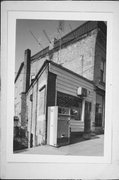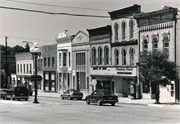Property Record
306 MAIN ST
Architecture and History Inventory
| Historic Name: | PHILIP LEWIE BARBER SHOP |
|---|---|
| Other Name: | PIZZA PANTRY |
| Contributing: | No |
| Reference Number: | 30949 |
| Location (Address): | 306 MAIN ST |
|---|---|
| County: | Lafayette |
| City: | Darlington |
| Township/Village: | |
| Unincorporated Community: | |
| Town: | |
| Range: | |
| Direction: | |
| Section: | |
| Quarter Section: | |
| Quarter/Quarter Section: |
| Year Built: | |
|---|---|
| Additions: | |
| Survey Date: | 1982 |
| Historic Use: | retail building |
| Architectural Style: | Astylistic Utilitarian Building |
| Structural System: | |
| Wall Material: | Brick |
| Architect: | |
| Other Buildings On Site: | |
| Demolished?: | No |
| Demolished Date: |
| National/State Register Listing Name: | Main Street Historic District |
|---|---|
| National Register Listing Date: | 10/7/1994 |
| State Register Listing Date: | 7/15/1994 |
| National Register Multiple Property Name: |
| Additional Information: | A small stone triangular shaped one-story structure of coursed cut stone on an exposed basement that has stone lintels on the side elevation (windows now filled in). The store front has been completely altered for contemporary use. This building has been part of the architectural landscape of Darlington since the mid-19th century. This little stone building, originally a barber shop, is historically related to the early development of Darlington's commercial district. Built prior to 1884, this building has historically been a barber shop. For over thirty years the establishment was known as Philip Lewie's Barber Shop. It was advertised as the little store near the railroad crossing. Lewis's ads reported it as "the oldest and best establishment in Darlington," and Lewie was "boss barber for 18 years."(E) It was next known as the Taylor Brothers barber shop (1895-1912).(B,C) William and Roger Taylor were in business together until about the turn of the century. By 1901 William Taylor was operating alone.(D) According to a local businessman, Louis Sandefur, also a barber, was located in the building after the turn of the century.(B,D) By 1911 the shop was known as Taylor and Master (William Taylor and G. D. Master (Barbers."(C) A few years later it became a clothing store. Again it was called "the little store by the railroad crossing" with Osee Morgan, proprietor.(F) It has changed hands since the late 1920s and just recently was converted into a pizza parlor. |
|---|---|
| Bibliographic References: | Sanborn-Perris Maps, Darlington, 1884, 1889, 1894, 1900, 1908, 1915, 1924. Kenneth Schreiter, Interview, 1-10-83. "Wisconsin State Gazetteer," 1895, p. 256; 1911-12, p. 269. "Wisconsin State Gazetteer," 1901-02, p. 278. "Darlington Republican," January 7, 1881. "Republican Journal," September 13, 1917. |
| Wisconsin Architecture and History Inventory, State Historic Preservation Office, Wisconsin Historical Society, Madison, Wisconsin |


